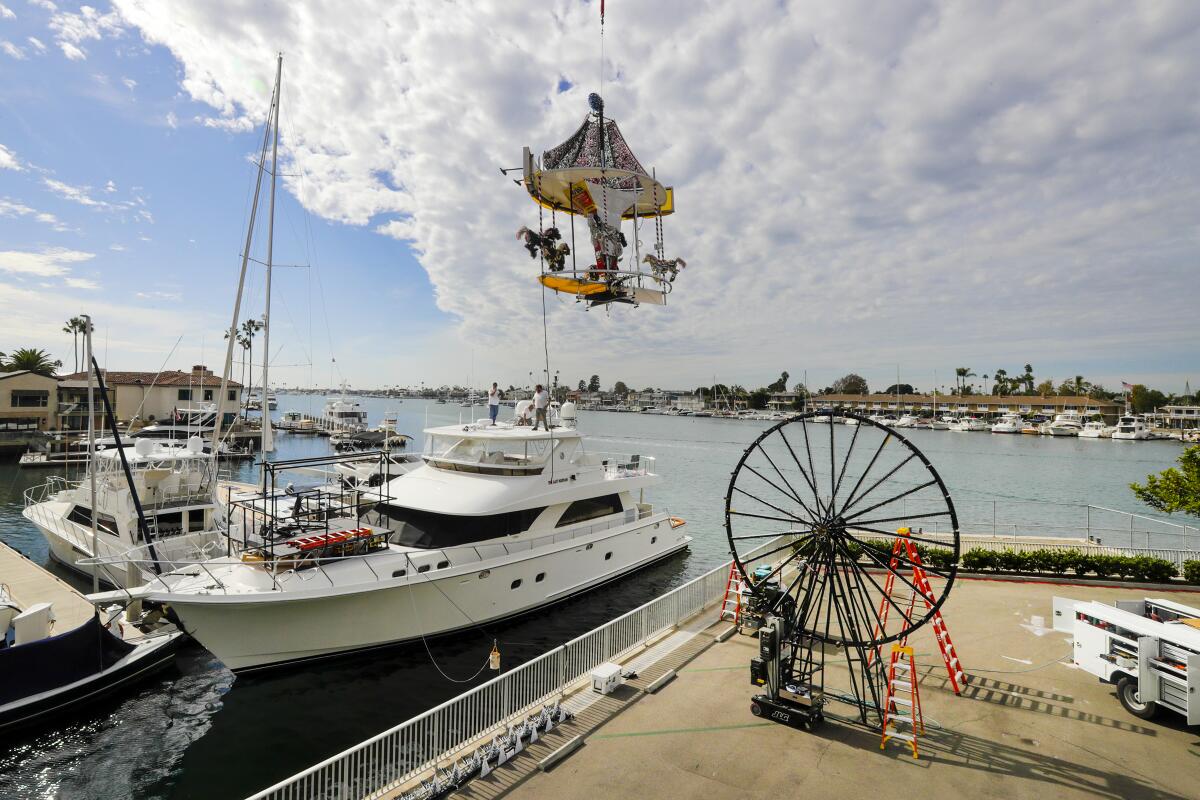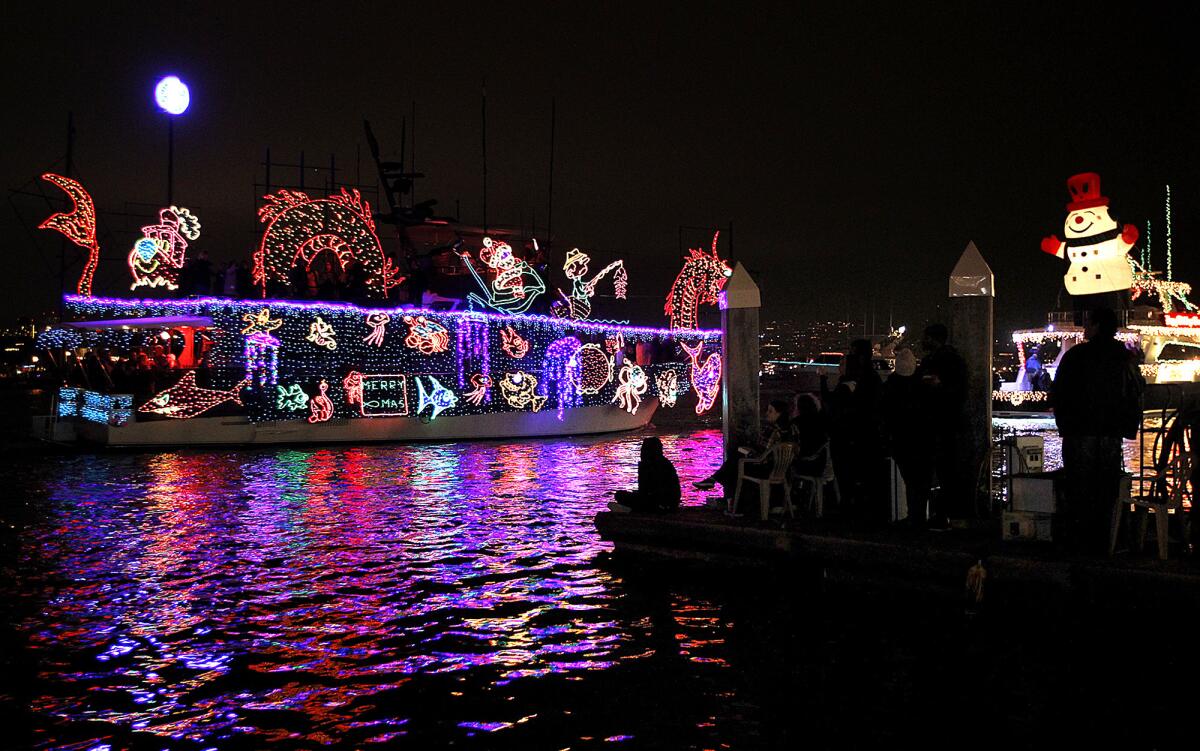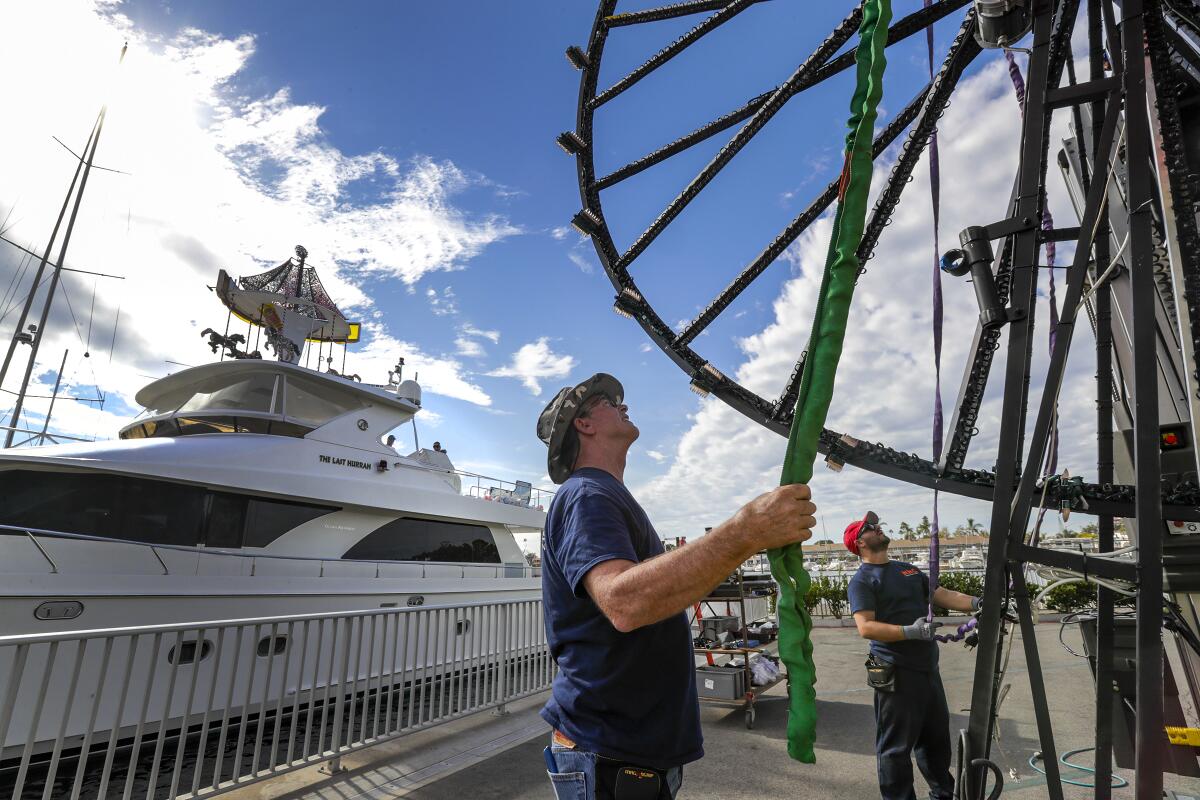Newport Beach boat parade rings in the holidays — and millions in revenue

- Share via
The Harborside Restaurant and the Newport Landing, two bayside eateries in Newport Beach, began to accept reservations in early September for tables with views of the city’s annual holiday boat parade — more than four months before the mid-December shindig.
But even that far in advance, it only took a few weeks to book up every table for the five-day event at both restaurants, including the upstairs ballroom at the Harborside Restaurant. That’s nightly seating for more than 900 people, who planned ahead to get front-row seats to a parade of brightly decorated boats that blast music and circle a three-mile harbor.
“It was over 90 degrees outside and we were taking reservations for this holiday celebration,” said Justin Turner, vice president of operations for the two restaurants.
The annual Newport Beach Christmas Boat Parade cast off with humble beginnings 111 years ago with a single gondola and a few canoes in tow. Now it’s an economic tsunami that draws more than 150 boats and thousands of visitors who crowd restaurants and hotels, spending millions of dollars on lodging, food and drinks.
And that doesn’t take into account the boat owners who invest heavily to cram their ships with LED lights, flamethrowers, inflatable characters, live bands and DJs. Some begin dreaming up boat decorations six months in advance.
Think of it as a floating version — albeit on a smaller scale — of Pasadena’s Rose Parade.
The boat parade, running Dec. 18 to 22, has a celebrity grand marshal — HGTV star Christina Anstead — plus a launch party at a nearby park featuring face painting, live music, food vendors and a doughnut wall.
At one point in the parade’s history, the celebration fell out of favor with city leaders because it drew too many noisy out-of-town visitors. As many as 200,000 people now watch the parade each night, more than double the population of the swanky beachside town.
Unlike the city leaders of the past, Newport Beach officials now welcome them all — and their money.
“It’s gotten a life of its own,” said Gary Sherwin, chief executive of Newport Beach & Co., the city’s marketing organization.

It’s become such a big tourist draw that even the Disneyland Resort entered a boat three years ago, decorated with characters from its Main Street Electrical Parade.
The Harborside Restaurant whips up a prix fixe dinner menu during the parade, charging $75 a person, and local charter companies that during the rest of the year ferry tourists to Catalina Island or on whale-watching excursions add evening cruises around the harbor for a closeup view of the parade.
“People are vying to get the best view,” said Brett Karas, operating manager of the Lido Bottle Works, a restaurant near the north end of the harbor. The eatery seats 68 people, and Karas says every table is usually booked for all five nights of the parade.
“It’s definitely lucrative, not just for restaurants but a lot of retail stores,” Karas added. “Everyone benefits for sure with that extra foot traffic.”
Visitors and locals spend an estimated $9.4 million during the parade each year, with $7.3 million of that coming from out-of-town visitors, who book 1,120 hotel rooms per night — about a third of the city’s inventory of 3,200 hotel rooms, according to a 2017 study commissioned by Newport Beach & Co.
High-end rooms at the posh Balboa Bay Resort are booked up weeks in advance.
The resort, which includes condos, three restaurants and a private club, has 159 rooms, including 42 rooms with a view of the bay. Even the 1,700-square-foot Governor’s Suite, for $800 a night, and the 3,000-square-foot Presidential Suite, for $2,800 a night, are in high demand.
The parade has become such a big revenue generator that the resort is launching private viewing parties for guests this year.
“There is music and lots of festivities and food,” said Marina Dutton, general manager of the Balboa Bay Resort. “The tradition is getting bigger and bigger each year.”
The tradition began, according to parade organizers, in 1907 when an Italian gondolier named John Scarpa took a group of visitors from Pasadena across the bay in a gondola decorated with Japanese lanterns. A year later, on July 4, Scarpa’s gondola led a group of local boat operators in eight canoes, all illuminated by Japanese lanterns.
Each year, the parade has grown bigger and, over time, has come to include a boat decorating contest. At one point, it even featured a derelict boat hull that was set on fire in the bay.
The parade was put on hold during World War I but was revived in 1919 thanks to the leadership of Joseph Beek, a ferry boat operator. In 1949, the parade became so big that city leaders sought to crack down on the rowdy crowds of summer visitors it drew.
Beek took a lead role in relaunching the parade as a Christmastime procession, and the event was eventually taken over by the city’s Chamber of Commerce.
“Ever since then, that parade has turned into a beast,” said David Beek, the grandson of Joseph Beek and co-chair of the parade. He also runs a marine fuel dock on Balboa Island.
Every major business in the city, including the supermarkets and the charter boat companies, record their best profits during the five days of the parade, Beek said.
“If my grandfather was around to see how big it has blown up,” he said, “he would be amazed.”

Joseph Beek might also be amazed at the investment some boat owners make to decorate their ships for the parade.
On a recent weekday, about half a dozen men at the Balboa Marina were working to guide a 40-ton crane to install decorations that resembled a miniature carousel and a Ferris wheel onto an 80-foot yacht, the Last Hurrah.
The vessel’s owners, Robert Meadows and Cathleen Vick, operators of an electrical contracting company, have been participating in the parade for years. Each year, they try to outdo their previous efforts, said Shaun Crossman, the yacht’s captain.
In addition to the carousel and the Ferris wheel, Crossman said, the ship will feature 86,000 LED lights, a live DJ on a stage, and air cannons that shoot T-shirts into the crowds.
The challenge, he said, is to install the decorations without drilling holes into the body of the boat. Clamps and sandbags help keep the stage and decorations from shifting during the 2½-hour cruise of the bay.
Crossman declined to say how much was spent this year to decorate the ship, but the crane alone costs $1,000 an hour to rent.
Jerry Clowes, a fabricator for the ship’s owners, began designing the carnival-themed light display six months earlier. The big payoff, he said, is when the crowds on the shore see the boat and respond with cheers and applause.
“The colors we use, the way it lights up, you will notice a difference over last year,” Clowes said. “We are all about the crowds.”
More to Read
Inside the business of entertainment
The Wide Shot brings you news, analysis and insights on everything from streaming wars to production — and what it all means for the future.
You may occasionally receive promotional content from the Los Angeles Times.











